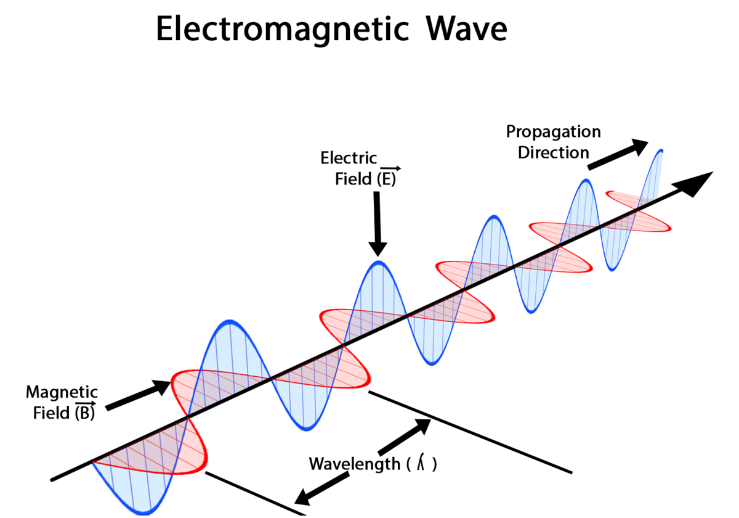
How long are infrared waves compared with waves of visible light?
Answer
429.9k+ views
Hint: The distance between two successive crests of a wave, or the distance between two successive troughs of a wave is known as wavelength. It is denoted by $\lambda $. Visible light waves and infrared rays are electromagnetic in nature.
Complete answer:
We know that the transverse waves which are created because of synchronized oscillations or vibrations between a magnetic field and the electric field are known as electromagnetic waves, also called EM waves. The EM waves travel through a speed of light in vacuum. EM waves can be refracted as well as reflected, and they also are carriers and transporters of energy.

Now, the range of all the types of EM radiations is known as the electromagnetic spectrum. The two factors which decide the position of the EM wave on the electromagnetic spectrum are
1. Wavelength
2. Frequency of oscillations
The frequency of the waves in the electromagnetic spectrum ranges from below one hertz to above ${{10}^{25}}$ hertz. And hence the wavelength ranges from fraction of the size of the atomic nucleus to thousands of kilometers.
The electromagnetic spectrum is divided into different frequency bands and each frequency band has a different name. This is because different frequency bands have different sources and also, they differ in how they affect matter.
The order of the bands in the electromagnetic spectrum in decreasing order of wavelength or increasing order of frequency are
1. Radio waves
2. Microwaves
3. Infrared radiation
4. Visible light
5. Ultraviolet radiation
6. X-rays
7. Gamma rays
We know that the wavelength of infrared waves ranges from 700 nm to 1mm. The wavelength of visible light ranges from 400 nm to 700 nm.
So, infrared waves are longer than visible light waves by 0.0004 mm or ${{10}^{-4}}$m.
Note:
The relation between wavelength and frequency, in vacuum, can be defined by the
\[\lambda v=c\]
Where v is the frequency, $\lambda $ is the wavelength and c is the speed of light.
From this formula we can see that frequency and wavelength are inversely proportional. That means that when there is an increase in wavelength, the frequency decreases.
Complete answer:
We know that the transverse waves which are created because of synchronized oscillations or vibrations between a magnetic field and the electric field are known as electromagnetic waves, also called EM waves. The EM waves travel through a speed of light in vacuum. EM waves can be refracted as well as reflected, and they also are carriers and transporters of energy.

Now, the range of all the types of EM radiations is known as the electromagnetic spectrum. The two factors which decide the position of the EM wave on the electromagnetic spectrum are
1. Wavelength
2. Frequency of oscillations
The frequency of the waves in the electromagnetic spectrum ranges from below one hertz to above ${{10}^{25}}$ hertz. And hence the wavelength ranges from fraction of the size of the atomic nucleus to thousands of kilometers.
The electromagnetic spectrum is divided into different frequency bands and each frequency band has a different name. This is because different frequency bands have different sources and also, they differ in how they affect matter.
The order of the bands in the electromagnetic spectrum in decreasing order of wavelength or increasing order of frequency are
1. Radio waves
2. Microwaves
3. Infrared radiation
4. Visible light
5. Ultraviolet radiation
6. X-rays
7. Gamma rays
We know that the wavelength of infrared waves ranges from 700 nm to 1mm. The wavelength of visible light ranges from 400 nm to 700 nm.
So, infrared waves are longer than visible light waves by 0.0004 mm or ${{10}^{-4}}$m.
Note:
The relation between wavelength and frequency, in vacuum, can be defined by the
\[\lambda v=c\]
Where v is the frequency, $\lambda $ is the wavelength and c is the speed of light.
From this formula we can see that frequency and wavelength are inversely proportional. That means that when there is an increase in wavelength, the frequency decreases.
Recently Updated Pages
Master Class 11 Accountancy: Engaging Questions & Answers for Success

What percentage of the area in India is covered by class 10 social science CBSE

The area of a 6m wide road outside a garden in all class 10 maths CBSE

What is the electric flux through a cube of side 1 class 10 physics CBSE

If one root of x2 x k 0 maybe the square of the other class 10 maths CBSE

The radius and height of a cylinder are in the ratio class 10 maths CBSE

Trending doubts
The Equation xxx + 2 is Satisfied when x is Equal to Class 10 Maths

Why is there a time difference of about 5 hours between class 10 social science CBSE

Change the following sentences into negative and interrogative class 10 english CBSE

What constitutes the central nervous system How are class 10 biology CBSE

Write a letter to the principal requesting him to grant class 10 english CBSE

Explain the Treaty of Vienna of 1815 class 10 social science CBSE




